There are hundreds – thousands – of math books, math programs, and math curricula – but remember sometimes what’s most effective in terms of promoting mathematical thinking doesn’t look much like conventional math at all. Let the kids do puzzles and teach them to play chess.
Table of Contents
NOT JUST YOUR ORDINARY BOOKS ABOUT MATH
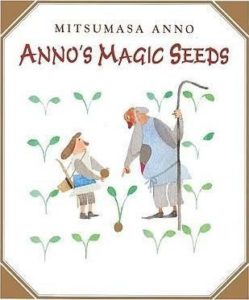 |
In Mitsumasa Anno’s Anno’s Magic Seeds (Puffin, 1999), Jack meets a wizard who gives him two golden seeds, telling him to plant one and eat the other (“You will not be hungry again for a whole year”). Jack does, and the seed grows into a lovely blue-flowered plant that produces two seeds. Eventually Jack decides to eat something different for a change, and this time plants both seeds, getting two plants and a harvest of four seeds. This time he eats one and plants three – and things rapidly multiply, becoming more and more complicated. For ages 4 and up. |
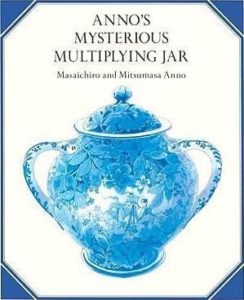 |
By Masaichiro Anno and Mitsumasa Anno, Anno’s Mysterious Multiplying Jar (Penguin Putnam, 1999) is a wonderful introduction to the concept of factorials through the medium of a blue-and-white Oriental jar. The jar, opened, contains an ocean in which there are two islands. Each island has two countries; each country has three mountains; on each mountain, there are four walled kingdoms; and so on. A gorgeous multiplication problem ending up with a phenomenal number of jars. For ages 4 and up. |
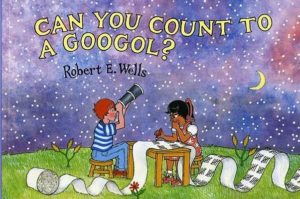 |
By Robert E. Wells, Can You Count to a Googol? (Albert Whitman & Company, 2000) is a counting book by tens (beginning with one banana, balanced on a nose) and moving up through 1000 (scoops of ice cream), 100,000 (marshamallows), and so on, ending with an explanation of the googol (a 1 with 100 zeroes after it) and how it was named by a nine-year-old boy. A googol, Wells points out, is much too enormous to illustrate (“If you counted every grain of sand on all the worlds’ beaches and every drop of water in all the oceans, that wouldn’t even be CLOSE…”). For ages 6-9. |
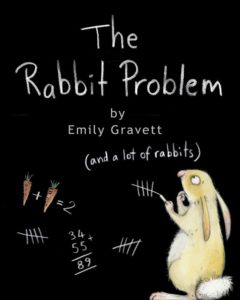 |
Emily Gravett’s The Rabbit Problem (Simon & Schuster, 2010) is a delightful month-by-month take on the Fibonacci series – which is named for the mathematician who first described it in the 13th century, while solving a problem about multiplying rabbits. First there’s one lonely rabbit (an invitation stuck to the page reads “Join me”); subsequent months feature baby rabbit record books, rabbit newspapers, carrot recipes, and – by November – wildly overcrowded rabbits. For ages 6-11. |
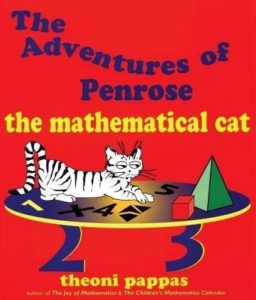 |
Theoni Pappas is the inventor of Penrose the Mathematical Cat, featured in The Adventures of Penrose the Mathematical Cat (World Wide Publishing/Tetra, 1997) and Fractals, Googols, and Other Mathematical Tales (1993). Each is a collection of mathematical stories in which Penrose explores pancake world, meets a fractal dragon and a Fibonacci rabbit, discovers the golden rectangle and the world of Tangrams, visits the planet Dodeka, and more. Friendly introductions to interesting math concepts for ages 7-11.
Also by Pappas, see Fractals, Googols, and Other Mathematical Tales (1993). |
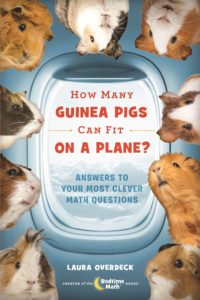 |
Laura Overdeck’s How Many Guinea Pigs Can Fit on a Plane? (Feiwel and Friends, 2017) includes such irresistible math questions as: How many bees does it take to make a jar of honey? How many soccer balls would fit inside a hollow Earth? For ages 7-11. |
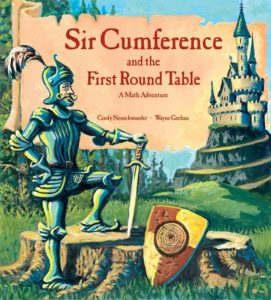 |
Author Cindy Neuschwander introduces kids to geometry through the adventures of gallant Sir Cumference, his wife, Lady Di of Ameter, their son, Prince Radius, and a cast of supporting characters. Titles in the series include Sir Cumference and the First Round Table (Charlesbridge, 1994), Sir Cumference and the Dragon of Pi (1999), and Sir Cumference and the Great Knight of Angleland (2001). For ages 8-12. |
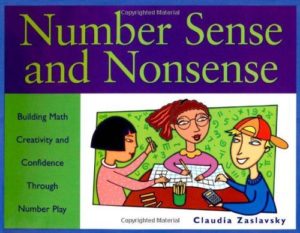 |
Cynthia Zaslavsky’s Number Sense and Nonsense (Chicago Review Press, 2001) is subtitled “Building Math Creativity and Confidence Through Number Play” – which it attempts to do by encouraging kids to fool around with number games and puzzles. Chapter titles include “Odds and Evens,” “Prime and Not Prime,” “Zero – Is It Something? Is It Nothing?” “Money, Measures, and Other Matters,” “Counting: Fingers, Words, Sticks, Strings, and Symbols,” and “The Calculator and Number Sense.” Figure out how many of what arrive over the Twelve Days of Christmas, solve the problem of the King’s Chessboard, play a Liberian stone game, and much more. For ages 8 and up. |
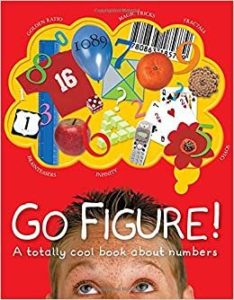 |
Johnny Ball’s award-winning Go Figure! (Dorling Kindersley, 2005) is subtitled “a totally cool book about numbers,” and it is just that. Illustrated with great color photos, charts, and diagrams, the book covers the origins of counting, “magic numbers” (such as Fibonacci numbers, the golden ratio, pi, and Pascal’s triangle), geometry (including polyhedra, buckyballs, cones and curves, and symmetry), and “The World of Math” (including probability, chaos theory, and fractals). Challenging puzzles and questions and a great read for ages 8-12. |
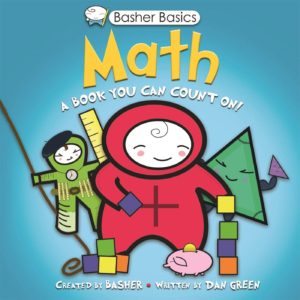 |
Simon Basher’s Math: A Book You Can Count On (Kingfisher, 2010) – in classic snarky Basher fashion – personifies mathematical concepts as first-person entities, each with its own Japanese-style cartoon character. For example, here’s Subtract: “People often think I’m gloomy. Okay, I admit it, I’m the exact opposite of Add, that bubbly ball of smirking positivity.” Learn all about Zero, Line, Quadrilateral, Ratio, and X. And more. For ages 9-14. |
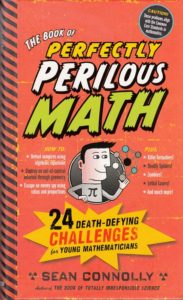 |
In Sean Connolly’s The Book of Perfectly Perilous Math (Workman, 2012), kids tackle problems like: “How many months would it take a single vampire to completely take over a town of 500,000 people?” For ages 9-15. |
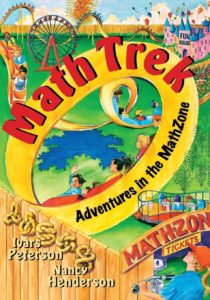 |
Math Trek by mathematician Ivars Peterson and Nancy Henderson (John Wiley & Sons, 1999) is a terrific interactive math book in ten short chapters, organized as an “amusement park” of mathematical concepts. Entry into the park – Chapter 1 – is through the Knot Zone; to get in, you have to figure out which of the knots that locks the gate is NOT a KNOT. Kids then experiment with knots (and non-knots) by duplicating patterns with string, find out how to make a trefoil knot (the simplest of mathematical knots) and a Jacob’s ladder knot (an impressive-looking non-knot) and learn a good deal about knot theory, its uses, and its history. At the Crazy Roller Coaster – it’s a Mobius strip – kids make Mobius strip models, learn about topology, and see some interesting examples of topological artwork. In other chapters, they learn about fractals and make fractal snowflakes, experiment with “weird dice,” build a chaos machine, learn to decode a binary secret message, and much more. Included are a glossary and a supplementary reading list. For ages 9 and up. |
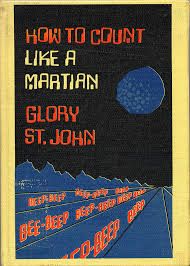 |
Glory St. John’s How to Count Like a Martian (Random House, 1975) begins with mysterious beeps from Mars – which might just be numbers. The book then covers a range of number systems, among them those of the Egyptians, Babylonians, Mayans, Greeks, Chinese, and Hindus, plus abaci and computers. Out of print; check your local library. For ages 9-12. |
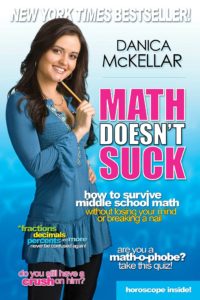 |
Actress Danica McKellar is also a math whiz, and is now known not only for movies and TV, but for educational advocacy, especially when it comes to girls and math. Titles of her informative, friendly, and funny books include Math Doesn’t Suck: How to Survive Middle School Math (Plume, 2008), Kiss My Math: Showing Pre-Algebra Who’s Boss (Plume, 2009), Hot X: Algebra Exposed (Plume, 2011), and Girls Get Curves: Geometry Takes Shape (Hudson Street Press, 2012). Readers learn math using friendship bracelets, shoes, shopping, pizza, and cute boys. And anyway, who can resist chapter titles like “How to Entertain Yourself While Babysitting a Devil Child” and “Creative Uses for Bubblegum”? For ages 11 and up. |
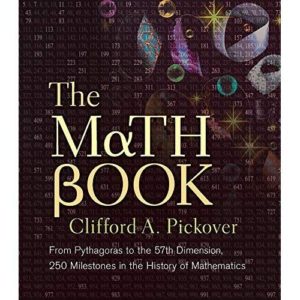 |
Clifford A. Pickover’s The Math Book (Sterling, 2012) is a fascinating chronological history of mathematics “From Pythagoras to the 57th Dimension” in 250 double-page spreads, each illustrated with great color photographs. Actually it starts well before Pythagoras: the first entry, “Ant Odometer,” is dated 150 million BC. Other entries include Zeno’s Paradox, Archimedes’s Spiral, Franklin’s Magic Squares, Turing Machines, Rubik’s Cube, and Fractals. Something for everybody. |
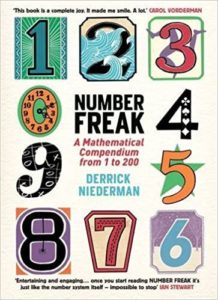 |
Derrick Niederman’s Number Freak (Perigee, 2009) runs from 1 to 200, listing interesting facts and background information about each number. For example, at 23, you find out about the birthday paradox; at 46, you learn that there are 46 peaks in the Adirondack Mountains and that a “46-er” is someone who has climbed them all; and at 85, you find that there are just 85 ways in which to knot a necktie. For teenagers and adults. |
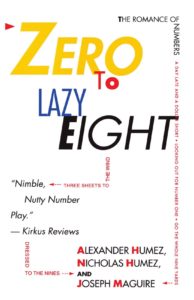 |
By Alexander Humez, Zero to Lazy Eight (Touchstone, 1994) is an information-packed collection of essays, variously on zero, the numbers 1 to 13, and infinity. Readers learn about everything from numerical word origins to the mathematics of ciphers, bell-ringing, and dice games. Find out why we say “three sheets to the wind” and “dressed to the nines.” For teenagers and adults. |
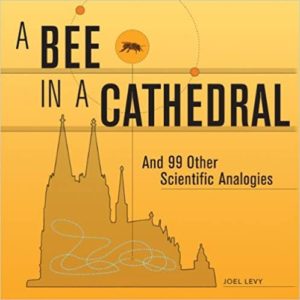 |
When it comes to communicating complex concepts, analogies are often the way to go, and Joel Levy’s A Bee in a Cathedral and 99 Other Scientific Analogies (Firefly Books, 2011) is crammed with nothing but. The book is divided into seven graphically creative sections, variously covering physics, chemistry, biology, astronomy, earth science, the human body, and technology. For example, if an atom were the size of a cathedral, its nucleus would be the size of a bee. For teenagers and adults. |
| By author and mathematician Keith Devlin, Devlin’s Angle is a collection of monthly columns written for the Mathematical Association of America on math in everyday life and math education. Check them out. | |
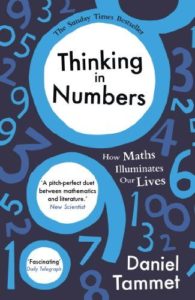 |
By autistic savant Daniel Tammet (author of Born on a Blue Day), Thinking in Numbers (Little, Brown, 2013) is a collection of 25 essays about seeing the world through numbers, with anecdotes and examples that range from haiku to chess, snowflakes, and Omar Khayyam’s calendar. Recommended for both math-loving and totally math-phobic teenagers and adults. |
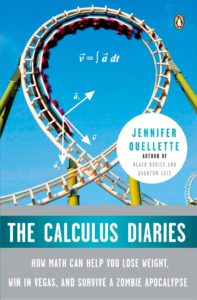 |
Jennifer Ouellette’s The Calculus Diaries (Penguin Books, 2010), subtitled “How Math Can Help You Lose Weight, Win in Vegas, and Survive a Zombie Apocalypse,” is a truly reader-friendly account of applying calculus to everyday life by a self-described math-phobic. Crammed with intriguing anecdotes and examples, from Disneyland’s spinning tea cups to speedometers, the Black Death, tulipomania, and the housing bubble. For teenagers and adults. |
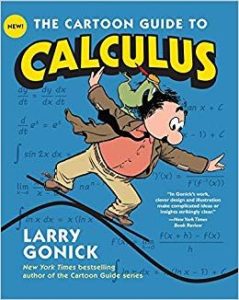 |
Larry Gonick’s 230+-page The Cartoon Guide to Calculus (William Morrow, 2011) covers all the basics with wonderful little cartoon illustrations and a sense of humor. Delightful, which is something I never thought I’d hear myself say about calculus. Chapter titles include “Speed, Velocity, Change,” “Meet the Functions,” “Limits,” “The Derivative,” and “Introducing Integration.” For all students of calculus. |
